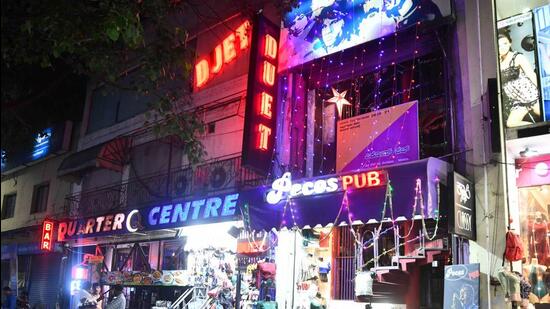
MY TWO BANGALORES: STREET AND LUXURY
Anyone who says Bengaluru is an expensive city has not been to Shivaji Nagar in the evenings. Forget the main Commercial street. Take any of the small gullies to its right and walk down a few yards to Ibrahim Sahib Street, Veera Pillai Street and Lubbay Masjid Street. Here, at street corners, you will find a plethora of modest restaurants serving tasty inexpensive food. Some have no names. It is just a lady sitting inside a storefront serving freshly made pakoras, dosas or boiled corn with toppings. One evening, I walked down Jewellers Street to U.P. Bhavan where an elderly husband and wife manned the counter (and it seemed, the cooking). The wife was slicing and spicing green chilies that were served along with my ₹20 samosa order, topped with a sweet tamarind and green coriander chutney. As I stood awkwardly in the small space and tried to eat, the woman wordlessly moved the spices she had been mixing and asked me to sit and eat. “Aaram se,” she said softly. Relax, enjoy the food. This was old fashioned Indian hospitality.
The same with Jayanagar 4th block market. You go there to shop for costume jewellery, puja items, or readymade kurtas. But you end up eating—a lot. Every street corner has push carts selling raw mango, cut watermelon, pani puri and spicy potato chips on a stick. You can easily spend a couple of hours here—people watching, shopping, and ducking into the tiny shops where you can find tailors who will repair your torn jeans, jewellers who will melt your gold jewels, and shopkeepers who will make fresh pillows stuffed with polyester fabric or (more expensive) cotton stuffing.
There are two Bengalurus I inhabit and I love both. One is the world of fine dining, wine and luxury and the other is the gullies and streets. If you are new in Bangalore, and are a professional
I enjoy the ‘luxury’ Bangalore but I am head over heels in love with “street” Bengaluru. Rarely do these two worlds collide, but recently they did. I signed up for a mushroom foraging walk in Cubbon Park. We were about 15 people and followed an exuberant mycologist (someone who studies fungi, yeasts and mushrooms) named Hari for two hours hunting for mushrooms. They were everywhere. The next time you see dead trees or leaf litter, look around. You will see mushroom of all kinds around it. The walk was under the auspices of Nuvedo, founded by Jashin Hameed and Prithvi Kini (a husband and wife team). I came away with three bottles of mushroom extracts. They cost ₹1,500 per bottle so they are not cheap, but they are good for health and help with sleep and digestion.
I took a couple of thimbles of cordyceps mushrooms on the day I went to Loya at the Taj West End for lunch. The West End is a property like no other. When I visit, I touch the rain tree and look for woodpeckers near the back where a temple sits. Loya takes the place of Masala Klub and frankly, I find the food and drink in this new avatar a lot better. This is slow cooking inspired by the Bakarwal shepherds of Jammu & Kashmir. The result is unusual dishes, smoked flavours, Indian-inspired cocktails, and generous use of expensive ingredients—gucchhi or morels for instance. I like dense heavy food— paneer, dal makhani, chole—and my husband likes light food. Loya’s food would satisfy us both.
What Bengaluru lacks are regional flavours. Mangaluru’s food, for example, is underrepresented, even though there are countless “Mangy Bangies,” or Mangalorean Bangaloreans. Ouzo by Fire attempts to rectify this. It is a new standalone restaurant that serves ManGo cuisine or Mangalorean Goan, which means that it will forever be compared to “how my Mom used to make this dish.” Seafood is the star here and the cocktails use jamun and kokum for flavour. I loved the fresh “poi” breads and creative dips. Chef Milan Gupta is a fund of knowledge about coastal cuisine. I loved the sour taste of kokum that permeated many dishes, and the lightly spiced salads. Ghee roast—either the chicken or paneer version-- is the star here and if you haven’t tasted this, you really need to.
The Oberoi doesn’t really do pop-ups but recently, they did—to introduce their new chef, Anirban Dasgupta. At his opening dinner, he created a menu based on his life story. He devised a menu where every dish was from the regions where he had cooked at—beginning with Bengal, then to Goa, Jaipur, Delhi, the Northeast and finally Bengaluru. With every dish, he had placed cards with his personal take on cuisine. This was a wonderful way to introduce a chef, a cuisine, and a story. The Chef as storyteller, and along the way, showing off his prowess.
Where I end up after a night is at home with a book and a bottle of ginger kombucha. Bengaluru has a whole range of artisanal cheeses, kombuchas, breads and even paan. I keep trying many of them. As I write this, I am swigging a bottle of rose kombucha from Mossant Fermentary. It has been around for a while, but I like its new floral flavours—hibiscus, rose, and of course, my go-to, ginger.
How do you end your day?
(Shoba Narayan is Bengaluru-based award-winning author. She is also a freelance contributor who writes about art, food, fashion and travel for a number of publications.)
Read more news like this on HindustanTimes.com
2024-06-13T02:42:48Z dg43tfdfdgfd